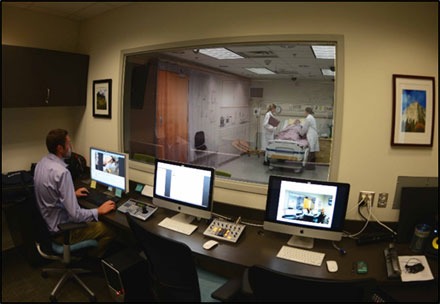W21C
Healthcare Human Factors and Simulation Laboratory
W21C (www.w21c.org) is a health systems research and innovation initiative based in the University of Calgary’s O’Brien Institute for Public Health and the Calgary Zone of Alberta Health Services. Our interdisciplinary team addresses health care needs through evidence-based practice, technology evaluation, and educational outreach - driving change in the health system to enhance patient safety and quality of care.
W21C human factors: research and infrastructure
Opportunities for innovation in health care require an understanding of how users (e.g., patients and care providers) behave in response to system constraints. The W21C Human Factors team studies the interaction between people and health care systems, to enhance care efficiency and safety through system design. Much of this research occurs at the Healthcare Human Factors and Simulation Laboratory (HHFSL), a state-of-the-art research simulation laboratory located at the University of Calgary. The HHFSL includes a high fidelity patient simulation room, complete with multiple human patient Simulators (e.g., CAE Healthcare’s iStan® and Blue Phantom™, and Laerdal’s Harvey® and SimMan® 3G).

The HHFSL is also outfitted with an advanced participant observation system, including: eight ceiling-mounted video cameras with pan, tilt and zoom capabilities, and; four directional compression microphones to pick-up verbal communication and device feedback as simulated scenarios are executed. All information is then captured in the control room through an integrated local area network and a closed-circuit AV system.
The simulation lab enables researchers to develop realistic clinical scenarios to study a range of human-system interactions in a controlled environment. Additionally, partnerships with the local health authority and provincial simulation programs allow our team to conduct research in actual healthcare settings outside of the HHFSL. These in-situ observations and the recorded data can be brought back for systematic analysis in the HHFSL control room.
Noldus behavioural analysis
Noldus software plays an integral role in the analysis of video and audio data. Our analysts develop coding taxonomies with multi-disciplinary teams of subject matter experts, to identify behaviours that are the most relevant to challenging health care problems. The Observer® XT provides our researchers with the capability to formalize those coding taxonomies, efficiently and reliably identifying patterns in human behaviour that are indicative of opportunities for improvement to design. When presenting research to external partners, behavioural analysis is one of the most powerful aspects of the lab. We have used Noldus technologies to examine: interactions between EMS providers, patients and ground ambulance design; multi-disciplinary teams and biases in decision making; interactions with medical devices; risks to health care workers managing patients with infectious diseases, and; clinical information systems.
Tours and external relations
Over the years, W21C has been privileged to host a variety of individuals and organizations through our doors, including the Duke and Duchess of Cambridge during their royal tour in 2011. In 2015 the W21C welcomed Her Royal Highness Princess Astrid of Belgium, where the team presented Human Factors research examining healthcare worker risks during the treatment of potential Ebola Virus Disease patients. Since 2012, the HHFSL has been a focal point of more than 100 tours with approximately 1200 visitors, including industry partners, academic collaborators, students, and the general public. These opportunities have allowed us to showcase key technology within the W21C Research and Innovation Centre, and our multidisciplinary efforts to improve patient safety and quality of care.
Contact information
Greg Hallihan (email: [email protected]), W21C, University of Calgary, Calgary, Canada.
 English
English German
German French
French Italian
Italian Spanish
Spanish Chinese
Chinese